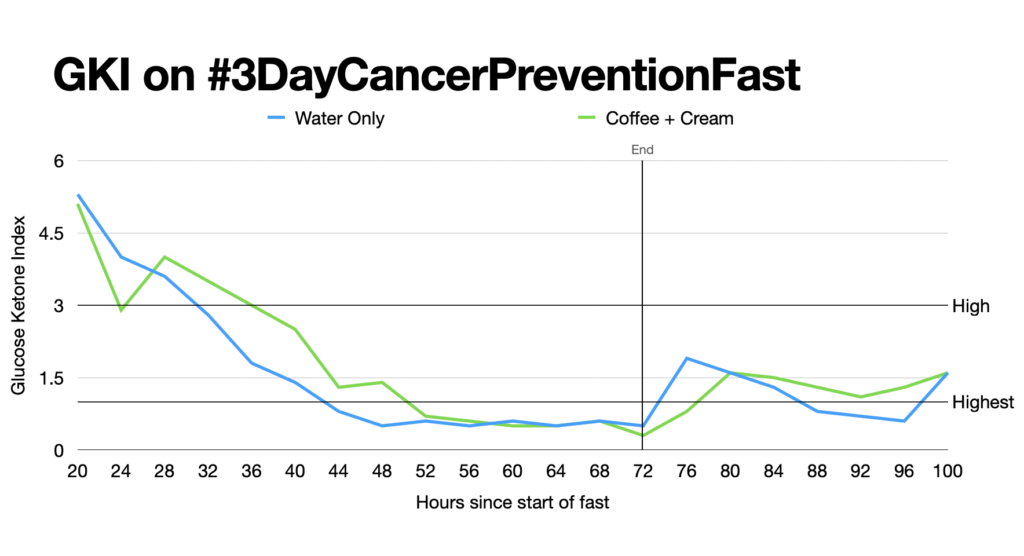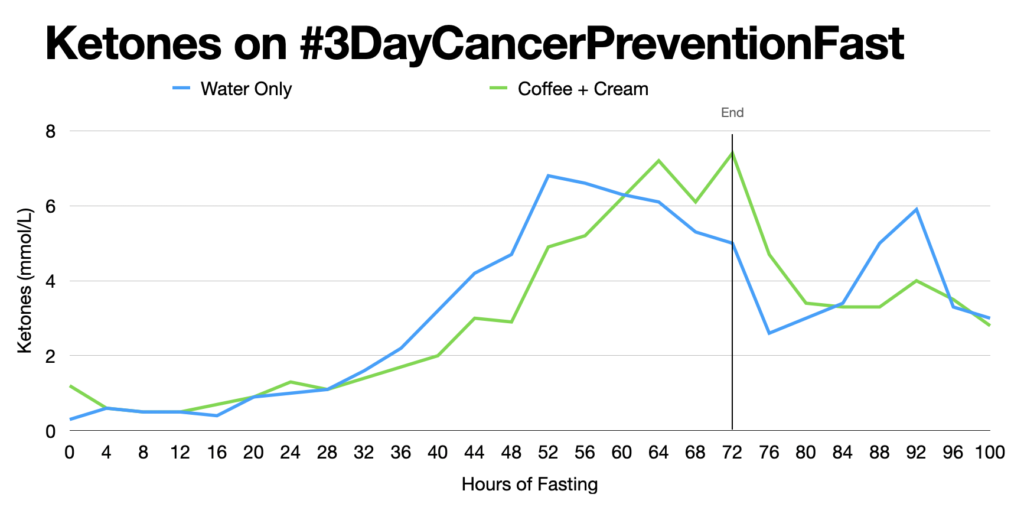I have undertaken several extended fasts for cancer prevention, and in January Lisa joined me for our first joint #3DayCancerPreventionFast.
Because we wanted to ensure that we were reaching the optimal therapeutic level of ketosis, we did a water-only fast that first time.
To gauge the fast’s effectiveness, we took blood glucose and ketone measurements several times each day using our Keto-Mojo meters, which provided a Glucose Ketone Index (GKI) score.
On a Standard American Diet (SAD), ketones are essentially nonexistent because glucose levels are high, and therefore insulin levels also are elevated. The liver produces ketones from fatty acids in the bloodstream, but this only happens when insulin levels are low enough to allow fat cells to release the fatty acids.
Professor Thomas Seyfried developed the GKI score to compare the levels of glucose and ketones in the bloodstream. A GKI less than 3 is considered a high level of therapeutic ketosis, while the highest level is <1, which is what Seyfried seeks to achieve in studies treating cancer patients.
Since Lisa and I are seeking to prevent cancer instead of treating it, we decided to set two GKI targets on our #3DayCancerPreventionFast:
- At least 72 hours with GKI<3 (High Level)
- At least 24 hours with GKI<1 (Highest Level)
In our January water-only fast we easily met those goals, as I had 44 hours of GKI below 1 and more than 70 hours below 3.
Lisa and I completed another three-day fast on Tuesday, but this time we allowed ourselves coffee with two tablespoons of cream, twice per day.
If we could make this accommodation while still reaching our GKI targets, this would make our monthly three-day fast much easier.
Here’s a graph of my GKI values for the water-only fast (blue line) as compared with the coffee + cream fast (green line):

One additional difference between the two fasts is that the first time I did an intense cardiovascular workout at about the 18-hour mark, while for the second I ran two miles when I was 26 hours in to the fast.
Both had the effect of raising blood sugar levels in the short term, breaking down liver glycogen in the first instance and through gluconeogenesis in the second, while also burning some of the ketones I was already generating.
Because I burned the ketones during my run they were no longer in my bloodstream, which temporarily boosted my GKI. This meant that in the second fast I was delayed by about 7 hours in getting below 3 GKI.
Still, I reached a GKI of 3 at the 36-hour mark, and stayed well below it for the next 64 hours. (In fact, my GKI this morning was 1.5, so I’ve had 76 hours so far in high-level therapeutic ketosis, and I had 27 hours below 1.)
Here’s a comparison of my ketone levels over the course of both fasts. Another key difference is that this time I went into the fast with higher ketone levels.

Three Lessons and a Caveat:
- Lessson 1: It’s good to start a fast already in dietary ketosis. For this week’s fast I was at GKI of 4, while I was at 15.3 when I started the water-only fast in January.
- Lesson 2: Intense cardio the morning after beginning a fast is better than doing it later in the afternoon. It burns through liver glycogen and accelerates progress of the fast.
- Lesson 3: Starting in ketosis and having a small amount of cream with coffee made this fast pretty easy. I really wasn’t very hungry, and I didn’t have caffeine withdrawal symptoms.
- Caveat: I don’t know that GKI<1 for 24 hours and GKI<3 for 72 hours are the right targets. Given the purpose of our fast, to accelerate autophagy in healthy cells and to put serious stress on (and hopefully kill) any cancer cells by depriving them of glucose, those seem reasonable to me. If you think different targets are appropriate, I’d like to hear your reasons in the comments below.
What’s next? When we do this again in April, I will plan to be sure I’m well into dietary ketosis as I’m starting the fast, and will do the intense cardio exercise early on the first morning.
Tomorrow I’ll share Lisa’s experiences in the two versions of the #3DayCancerPreventionFast.
To get these updates on a regular basis you can subscribe by email, or follow me on Facebook, Twitter and LinkedIn, where I’ll also be posting links.
Check out My Health Journey for the full story of our health improvements, and my #BodyBabySteps for an approach to how I would do it if I were starting today, based on what I’ve learned.